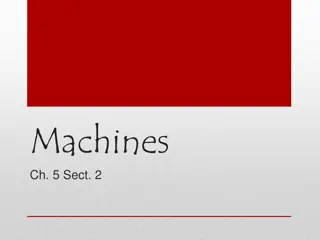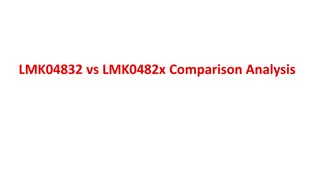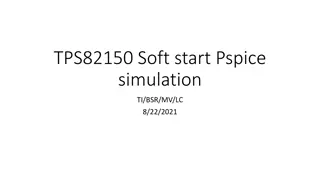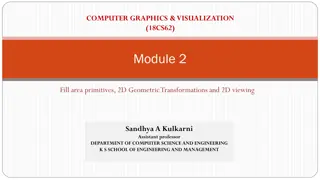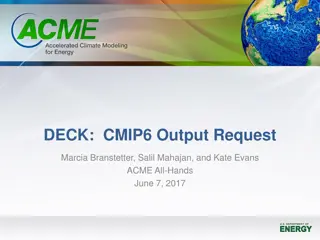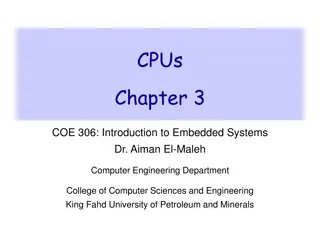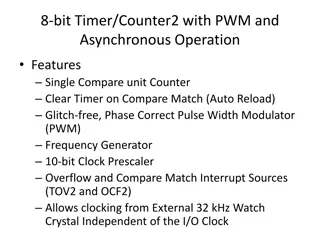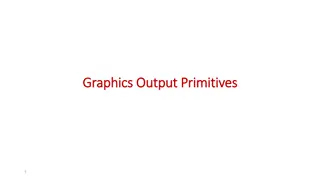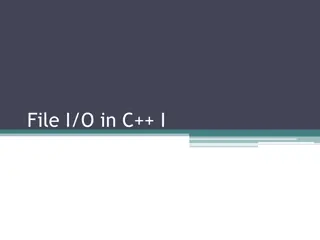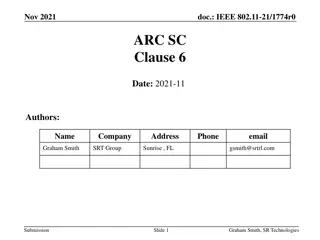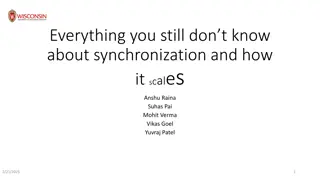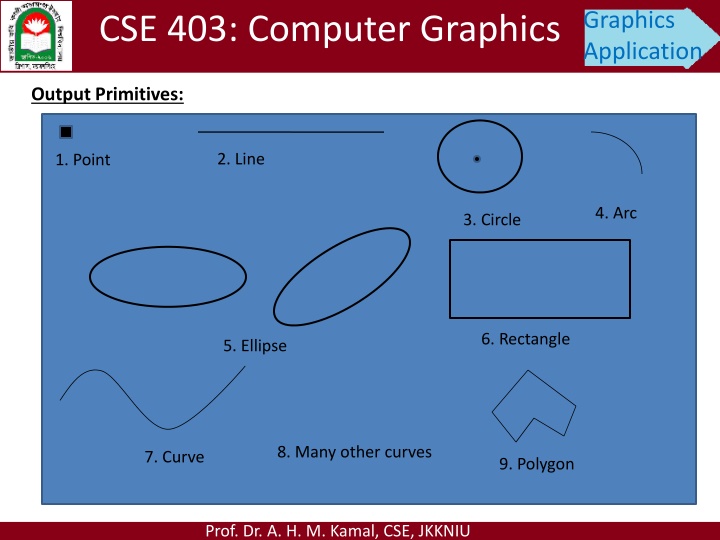
Computer Graphics Output Primitives and Functions Overview
Explore the fundamentals of computer graphics output primitives like lines, points, arcs, circles, rectangles, and more. Learn about point scan conversion, pixel intensity values, and C/C++ implementations for setPixel and getPixel functions in graphic applications. Dive into the world of graphics with Prof. Dr. A. H. M. Kamal from CSE, JKKNIU.
Download Presentation

Please find below an Image/Link to download the presentation.
The content on the website is provided AS IS for your information and personal use only. It may not be sold, licensed, or shared on other websites without obtaining consent from the author. If you encounter any issues during the download, it is possible that the publisher has removed the file from their server.
You are allowed to download the files provided on this website for personal or commercial use, subject to the condition that they are used lawfully. All files are the property of their respective owners.
The content on the website is provided AS IS for your information and personal use only. It may not be sold, licensed, or shared on other websites without obtaining consent from the author.
E N D
Presentation Transcript
Graphics Application CSE 403: Computer Graphics Output Primitives: 2. Line 1. Point 4. Arc 3. Circle 6. Rectangle 5. Ellipse 8. Many other curves 7. Curve 9. Polygon Prof. Dr. A. H. M. Kamal, CSE, JKKNIU
Graphics Application CSE 403: Computer Graphics Output Primitives: 1. Point : a small, squared and unit area in a sheet. Prof. Dr. A. H. M. Kamal, CSE, JKKNIU
Graphics Application CSE 403: Computer Graphics Output Primitives: 1. Point : is a mathematical point (x, y) within an image area hxw. Prof. Dr. A. H. M. Kamal, CSE, JKKNIU
Graphics Application CSE 403: Computer Graphics Output Primitives: 1. Point Scan Conversion: is digitizing a picture definition given in an application program into a set of pixel intensity values for storing in the frame buffer. Prof. Dr. A. H. M. Kamal, CSE, JKKNIU
Graphics Application CSE 403: Computer Graphics Output Primitives: 1. Point Scan Conversion: is digitizing a picture definition given in an application program into a set of pixel intensity values for storing in the frame buffer. Point scan conversion functions: setPixel(x,y): draws a pixel at (x,y) position in the grid. getPixel(x,y): reads the color value of a pixel of a location (x, y) Prof. Dr. A. H. M. Kamal, CSE, JKKNIU
Graphics Application CSE 403: Computer Graphics Output Primitives: 1. Point Scan Conversion: is digitizing a picture definition given in an application program into a set of pixel intensity values for storing in the frame buffer. Point scan conversion functions: setPixel(x,y): draws a pixel at (x,y) position in the grid. getPixel(x,y): reads the color value of a pixel of a location (x, y) Using the function of C/C++: Implementation of setPixel(x,y) function: putpixel (x, y, c) Implementation of getPixel(x,y) function: c=getpixel (x, y) These functions draw/read a pixel of color value c to/from (x, y) location. Prof. Dr. A. H. M. Kamal, CSE, JKKNIU
Graphics Application CSE 403: Computer Graphics Output Primitives: 1. Point Scan Conversion: is digitizing a picture definition given in an application program into a set of pixel intensity values for storing in the frame buffer. Point scan conversion functions: setPixel(x,y): draws a pixel at (x,y) position in the grid. getPixel(x,y): reads the color value of a pixel of a location (x, y) Using the function of C/C++: Implementation of setPixel(x,y) function: putpixel (x, y, c) Implementation of getPixel(x,y) function: c=getpixel (x, y) These functions draw/read a pixel of color value c to/from (x, y) location. Question: Range of c? Each c value means? Prof. Dr. A. H. M. Kamal, CSE, JKKNIU
Graphics Application CSE 403: Computer Graphics Output Primitives: 1. Point Using the function of C/C++: putpixel (x, y, c) c=getpixel (x, y) Value of c Color and respective code value in C/C++ Header file to include in c/c++ program: graphics.h Including style: #include<graphics.h> Prof. Dr. A. H. M. Kamal, CSE, JKKNIU
Graphics Application CSE 403: Computer Graphics 2. Line Output Primitives: A line drawing is accomplished by computing intermediate positions between two end points along a line path. An output device fills these positional pixels between the end points. 1. A line in a sheet 2. A line in a grid 3. A scan converted line (connected gray color pixels) Prof. Dr. A. H. M. Kamal, CSE, JKKNIU
Graphics Application CSE 403: Computer Graphics 2. Line Output Primitives: A geometrical line may pass through two vertical pixels. Problem is to decide which pixel to light. Prof. Dr. A. H. M. Kamal, CSE, JKKNIU
Graphics Application CSE 403: Computer Graphics 2. Line Output Primitives: Scan converting a line using: 1. Direct application of line equation 2. Digital Differential Analyzer (DDA) 3. Bresenham s Line Algorithm Prof. Dr. A. H. M. Kamal, CSE, JKKNIU
Graphics Application CSE 403: Computer Graphics 2. Line Output Primitives: Scan converting a line using: 1. Direct application of line equation P2(x2,y2) Let two points in a graph sheet are P1 and P2 at coordinate positions (x1, y1) and (x2, y2), respectively. A line equation is y=mx+b. P1(x1,y1) Here, x1, y1, x2, y2 and m are known values. Set x= x1 and y=y1 Draw a pixel at (x, y) location in the output device. Increase x by 1. Compute y from line equation y=mx+b Draw a pixel at (x, y) location in the output device. Repeat the computing process of x and y and drawing pixel at (x, y) till x>x2. Repeat Prof. Dr. A. H. M. Kamal, CSE, JKKNIU
Graphics Application CSE 403: Computer Graphics 2. Line Output Primitives: Scan converting a line using: 1. Direct application of line equation Pd(xd,yd) Ps(xs,ys) Here, Ps is a start point, Pd is a destination point. Starting Step: x=xs=0. y=ys=b Step 2: x=xs+1, compute y. Draw pixel at (x, y) using putpixel(x,y,c) Step 3: x=xs+2, compute y. Draw pixel at (x, y) using putpixel(x,y,c) . . Last Step: x=xd, compute y. Draw pixel at (x, y) using putpixel(x,y,c) Prof. Dr. A. H. M. Kamal, CSE, JKKNIU
Graphics Application CSE 403: Computer Graphics 2. Line Output Primitives: Scan converting a line using: 1. Direct application of line equation Pd(xd,yd) Disadvantage: Consider the following scenario in left figure. Only three pixels are dawn. I does not looks like a line. Ps(xs,ys) Here, Ps is a start point, Pd is a destination point. Starting Step: x=xs=0. y=ys=b Step 2: x=xs+1, compute y. Draw pixel at (x, y) using putpixel(x,y,c) Step 3: x=xs+2, compute y. Draw pixel at (x, y) using putpixel(x,y,c) . . Last Step: x=xd, compute y. Draw pixel at (x, y) using putpixel(x,y,c) Prof. Dr. A. H. M. Kamal, CSE, JKKNIU
Graphics Application CSE 403: Computer Graphics 2. Line Output Primitives: Scan converting a line using: 1. Direct application of line equation Drawing in a graph paper Prof. Dr. A. H. M. Kamal, CSE, JKKNIU
Graphics Application CSE 403: Computer Graphics 2. Line Output Primitives: Scan converting a line using: 1. Direct application of line equation Prof. Dr. A. H. M. Kamal, CSE, JKKNIU
Graphics Application CSE 403: Computer Graphics 2. Line Output Primitives: Scan converting a line using: 1. Direct application of line equation Prof. Dr. A. H. M. Kamal, CSE, JKKNIU
Graphics Application CSE 403: Computer Graphics 2. Line Output Primitives: Scan converting a line using: 1. Direct application of line equation 2. Digital Differential Analyzer (DDA) 3. Bresenham s Line Algorithm Prof. Dr. A. H. M. Kamal, CSE, JKKNIU
Graphics Application CSE 403: Computer Graphics 2. Line Output Primitives: Scan converting a line using: 2. Digital Differential Analyzer (DDA) The digital differential analyzer algorithm is an incremental scan-conversion method. The approach performs calculation at each step using results of preceding step. Start point (x1, y1), end point (xm, yn) Suppose at step I, we have calculated a point (xi, yi) The next point that would be computed is (xi+1, yi+1) Computation process: 1. x=xm-x1 2. y=yn-y1 3. m= y/ x no yes |m| 1 x=x1, Step=x1 - xm putpixel(x,y,c) For k=2 to Step-1 x=x+ x, y=y+m putpixel(x,y,c) y=y1, x=1 x=x1, Step=y1 yn, InvSlope=1/m putpixel(x,y,c) For k=2 to Step-1 y=y+ y, x=x+ InvSlope putpixel(x,y,c) y=y1, y=1 Prof. Dr. A. H. M. Kamal, CSE, JKKNIU
Graphics Application CSE 403: Computer Graphics 2. Line Output Primitives: Scan converting a line using: 2. Digital Differential Analyzer (DDA) The digital differential analyzer algorithm is an incremental scan-conversion method. The approach performs calculation at each step using results of preceding step. DDA Algorithm Advantage: It is faster than the direct use of line equation It calculate points without any floating-point multiplication Disadvantage: Still, it adds floating points. Happens cumulative errors due to limited precision. When the line is long, calculated point may drift away from the true position. Start point (x1, y1), end point (xm, yn) Suppose at step I, we have calculated a point (xi, yi) The next point that would be computed is (xi+1, yi+1) Computation process: 1. x=xm-x1 2. y=yn-y1 3. m= y/ x no yes |m| 1 x=x1, Step=x1 - xm putpixel(x,y,c) For k=2 to Step-1 x=x+ x, y=y+m putpixel(x,y,c) y=y1, x=1 x=x1, Step=y1 yn putpixel(x,y,c) For k=2 to Step-1 y=y+ y, x=x+ InvSlope putpixel(x,y,c) y=y1, y=1 InvSlope=1/m Prof. Dr. A. H. M. Kamal, CSE, JKKNIU
Graphics Application CSE 403: Computer Graphics 2. Line Output Primitives: Scan converting a line using: 1. Direct application of line equation 2. Digital Differential Analyzer (DDA) 3. Bresenham s Line Algorithm Prof. Dr. A. H. M. Kamal, CSE, JKKNIU
Graphics Application CSE 403: Computer Graphics 2. Line Output Primitives: Scan converting a line using: 3. Bresenham s Line Algorithm True line by equation y=mx+b between the points P1 and P2. Target is to draw a line between two points P1 and P2. Prof. Dr. A. H. M. Kamal, CSE, JKKNIU
Graphics Application CSE 403: Computer Graphics 2. Line Output Primitives: Scan converting a line using: 3. Bresenham s Line Algorithm y x y x = 2 1 m Measure slope m by 2 1 If m 1 then exchange coordinates so that m < 1. True line by equation y=mx+b between the points P1 and P2. Here, m>1 Prof. Dr. A. H. M. Kamal, CSE, JKKNIU
Graphics Application CSE 403: Computer Graphics 2. Line Output Primitives: Scan converting a line using: 3. Bresenham s Line Algorithm y x y x = 2 1 m Measure slope m by 2 1 If m 1 then exchange coordinates so that m < 1. True line by equation y=mx+b between the points P1 and P2. Do it by rotating by 900 or -900 for drawing purpose only. Now m<1 Prof. Dr. A. H. M. Kamal, CSE, JKKNIU
Graphics Application CSE 403: Computer Graphics 2. Line Output Primitives: Scan converting a line using: 3. Bresenham s Line Algorithm y x y x = 2 1 m Measure slope m by 2 1 If m 1 then exchange coordinates so that m < 1. True line by equation y=mx+b between the points P1 and P2. Prof. Dr. A. H. M. Kamal, CSE, JKKNIU
Graphics Application CSE 403: Computer Graphics 2. Line Output Primitives: Scan converting a line using: 3. Bresenham s Line Algorithm y x y x = 2 1 m Measure slope m by 2 1 If m 1 then exchange coordinates so that m < 1. Set xi=x1 and yi=y1, draw a pixel at (xi, yi) location, here i=1 True line by equation y=mx+b between the points P1 and P2. Prof. Dr. A. H. M. Kamal, CSE, JKKNIU
Graphics Application CSE 403: Computer Graphics 2. Line Output Primitives: Scan converting a line using: 3. Bresenham s Line Algorithm y x y x = 2 1 m Measure slope m by 2 1 If m 1 then exchange coordinates so that m < 1. Set xi=x1 and yi=y1, draw a pixel at (xi, yi) location, here i=1 Increase xi by 1, that is xi=xi+1. Indicated column shown in Fig True line by equation y=mx+b between the points P1 and P2. Prof. Dr. A. H. M. Kamal, CSE, JKKNIU
Graphics Application CSE 403: Computer Graphics 2. Line Output Primitives: Scan converting a line using: 3. Bresenham s Line Algorithm y x y x = 2 1 m Measure slope m by 2 1 If m 1 then exchange coordinates so that m < 1. Set xi=x1 and yi=y1, draw a pixel at (xi, yi) location, here i=1 Increase xi by 1, that is xi=xi+1. Indicated column shown in Fig True line by equation y=mx+b between the points P1 and P2. What pixel to draw: red or green? Prof. Dr. A. H. M. Kamal, CSE, JKKNIU
Graphics Application CSE 403: Computer Graphics 2. Line Output Primitives: Scan converting a line using: 3. Bresenham s Line Algorithm y x y x = 2 1 m Measure slope m by 2 1 If m 1 then exchange coordinates so that m < 1. Set xi=x1 and yi=y1, draw a pixel at (xi, yi) location, here i=1 Increase xi by 1, that is xi=xi+1. Indicated column shown in Fig Here, yT = yi+1, yB = yi. t=yi+1 y, and s=y-yi s-t=2y-2yi-1 True line by equation y=mx+b between the points P1 and P2. Prof. Dr. A. H. M. Kamal, CSE, JKKNIU
Graphics Application CSE 403: Computer Graphics 2. Line Output Primitives: Scan converting a line using: 3. Bresenham s Line Algorithm y x y x = 2 1 m Measure slope m by 2 1 If m 1 then exchange coordinates so that m < 1. Set xi=x1 and yi=y1, draw a pixel at (xi, yi) location, here i=1 Increase xi by 1, that is xi=xi+1. Indicated column shown in Fig Here, yT = yi+1, yB = yi. t=yi+1 y, and s=y-yi s-t=2y-2yi-1=2m(xi+1)+2b-2yi-1 We know that m= y/ x. True line by equation y=mx+b between the points P1 and P2. Prof. Dr. A. H. M. Kamal, CSE, JKKNIU
Graphics Application CSE 403: Computer Graphics 2. Line Output Primitives: Scan converting a line using: 3. Bresenham s Line Algorithm y x y x = 2 1 m Measure slope m by 2 1 If m 1 then exchange coordinates so that m < 1. Set xi=x1 and yi=y1, draw a pixel at (xi, yi) location, here i=1 Increase xi by 1, that is xi=xi+1. Indicated column shown in Fig Here, yT = yi+1, yB = yi. t=yi+1 y, and s=y-yi s-t=2y-2yi-1=2m(xi+1)+2b-2yi-1=2 y/ x(xi+1)+2b-2yi-1 True line by equation y=mx+b between the points P1 and P2. Prof. Dr. A. H. M. Kamal, CSE, JKKNIU
Graphics Application CSE 403: Computer Graphics 2. Line Output Primitives: Scan converting a line using: 3. Bresenham s Line Algorithm y x y x = 2 1 m Measure slope m by 2 1 If m 1 then exchange coordinates so that m < 1. Set xi=x1 and yi=y1, draw a pixel at (xi, yi) location, here i=1 Increase xi by 1, that is xi=xi+1. Indicated column shown in Fig Here, yT = yi+1, yB = yi. t=yi+1 y, and s=y-yi s-t=2y-2yi-1=2m(xi+1)+2b-2yi-1=2 y/ x(xi+1)+2b-2yi-1 x(s-t) = 2 y*(xi+1)+2 x*b-2 x*yi- x*1 True line by equation y=mx+b between the points P1 and P2. Prof. Dr. A. H. M. Kamal, CSE, JKKNIU
Graphics Application CSE 403: Computer Graphics 2. Line Output Primitives: Scan converting a line using: 3. Bresenham s Line Algorithm y x y x = 2 1 m Measure slope m by 2 1 If m 1 then exchange coordinates so that m < 1. Set xi=x1 and yi=y1, draw a pixel at (xi, yi) location, here i=1 Increase xi by 1, that is xi=xi+1. Indicated column shown in Fig Here, yT = yi+1, yB = yi. t=yi+1 y, and s=y-yi s-t=2y-2yi-1=2m(xi+1)+2b-2yi-1=2 y/ x(xi+1)+2b-2yi-1 x(s-t) = 2 y*(xi+1)+2 x*b-2 x*yi- x =2 y*xi+2 y*1+2 x*b-2 x*yi- x True line by equation y=mx+b between the points P1 and P2. Prof. Dr. A. H. M. Kamal, CSE, JKKNIU
Graphics Application CSE 403: Computer Graphics 2. Line Output Primitives: Scan converting a line using: 3. Bresenham s Line Algorithm y x y x = 2 1 m Measure slope m by 2 1 If m 1 then exchange coordinates so that m < 1. Set xi=x1 and yi=y1, draw a pixel at (xi, yi) location, here i=1 Increase xi by 1, that is xi=xi+1. Indicated column shown in Fig Here, yT = yi+1, yB = yi. t=yi+1 y, and s=y-yi s-t=2y-2yi-1=2m(xi+1)+2b-2yi-1=2 y/ x(xi+1)+2b-2yi-1 x(s-t) = 2 y*xi+2 y*1+2 x*b-2 x*yi- x =2 y*xi- 2 x*yi+ 2 y+ x(2b-1) True line by equation y=mx+b between the points P1 and P2. Prof. Dr. A. H. M. Kamal, CSE, JKKNIU
Graphics Application CSE 403: Computer Graphics 2. Line Output Primitives: Scan converting a line using: 3. Bresenham s Line Algorithm y x y x = 2 1 m Measure slope m by 2 1 If m 1 then exchange coordinates so that m < 1. Set xi=x1 and yi=y1, draw a pixel at (xi, yi) location, here i=1 Increase xi by 1, that is xi=xi+1. Indicated column shown in Fig Here, yT = yi+1, yB = yi. t=yi+1 y, and s=y-yi s-t=2y-2yi-1=2m(xi+1)+2b-2yi-1=2 y/ x(xi+1)+2b-2yi-1 x(s-t) = 2 y*xi- 2 x*yi+ 2 y+ x(2b-1) Let C= 2 y+ x(2b-1) True line by equation y=mx+b between the points P1 and P2. Prof. Dr. A. H. M. Kamal, CSE, JKKNIU
Graphics Application CSE 403: Computer Graphics 2. Line Output Primitives: Scan converting a line using: 3. Bresenham s Line Algorithm y x y x = 2 1 m Measure slope m by 2 1 If m 1 then exchange coordinates so that m < 1. Set xi=x1 and yi=y1, draw a pixel at (xi, yi) location, here i=1 Increase xi by 1, that is xi=xi+1. Indicated column shown in Fig Here, yT = yi+1, yB = yi. t=yi+1 y, and s=y-yi s-t=2y-2yi-1=2m(xi+1)+2b-2yi-1=2 y/ x(xi+1)+2b-2yi-1 x(s-t) = 2 y*xi- 2 x*yi+ 2 y+ x(2b-1) Let C= 2 y+ x(2b-1), all are constant. x(s-t) = 2 y*xi- 2 x*yi +C True line by equation y=mx+b between the points P1 and P2. Prof. Dr. A. H. M. Kamal, CSE, JKKNIU
Graphics Application CSE 403: Computer Graphics 2. Line Output Primitives: Scan converting a line using: 3. Bresenham s Line Algorithm y x y x = 2 1 m Measure slope m by 2 1 If m 1 then exchange coordinates so that m < 1. Set xi=x1 and yi=y1, draw a pixel at (xi, yi) location, here i=1 Increase xi by 1, that is xi=xi+1. Indicated column shown in Fig Here, yT = yi+1, yB = yi. t=yi+1 y, and s=y-yi s-t=2y-2yi-1=2m(xi+1)+2b-2yi-1=2 y/ x(xi+1)+2b-2yi-1 x(s-t) = 2 y*xi- 2 x*yi+ 2 y+ x(2b-1) Let C= 2 y+ x(2b-1) , all are constant. x(s-t) = 2 y*xi- 2 x*yi +C True line by equation y=mx+b between the points P1 and P2. Again, let di = x(s-t), used di instead of d because s and t varies from pixel to pixel. Prof. Dr. A. H. M. Kamal, CSE, JKKNIU
Graphics Application CSE 403: Computer Graphics 2. Line Output Primitives: Scan converting a line using: 3. Bresenham s Line Algorithm y x y x = 2 1 m Measure slope m by 2 1 If m 1 then exchange coordinates so that m < 1. Set xi=x1 and yi=y1, draw a pixel at (xi, yi) location, here i=1 Increase xi by 1, that is xi=xi+1. Indicated column shown in Fig Here, yT = yi+1, yB = yi. t=yi+1 y, and s=y-yi s-t=2y-2yi-1=2m(xi+1)+2b-2yi-1=2 y/ x(xi+1)+2b-2yi-1 x(s-t) = 2 y*xi- 2 x*yi+ 2 y+ x(2b-1) Let C= 2 y+ x(2b-1) , all are constant. x(s-t) = 2 y*xi- 2 x*yi +C True line by equation y=mx+b between the points P1 and P2. Again, let di = x(s-t), used di instead of d because s and t varies from pixel to pixel. di = 2 y*xi- 2 x*yi +C Prof. Dr. A. H. M. Kamal, CSE, JKKNIU
Graphics Application CSE 403: Computer Graphics 2. Line Output Primitives: Scan converting a line using: 3. Bresenham s Line Algorithm y x y x = 2 1 m Measure slope m by 2 1 If m 1 then exchange coordinates so that m < 1. Set xi=x1 and yi=y1, draw a pixel at (xi, yi) location, here i=1 Increase xi by 1, that is xi=xi+1. Indicated column shown in Fig di = 2 y*xi- 2 x*yi +C This is decision parameter. True line by equation y=mx+b between the points P1 and P2. Prof. Dr. A. H. M. Kamal, CSE, JKKNIU
Graphics Application CSE 403: Computer Graphics 2. Line Output Primitives: Scan converting a line using: 3. Bresenham s Line Algorithm y x y x = 2 1 m Measure slope m by 2 1 If m 1 then exchange coordinates so that m < 1. Set xi=x1 and yi=y1, draw a pixel at (xi, yi) location, here i=1 Increase xi by 1, that is xi=xi+1. Indicated column shown in Fig di = 2 y*xi- 2 x*yi +C At next step, di+1 = 2 y*xi+1- 2 x*yi+1 +C True line by equation y=mx+b between the points P1 and P2. Prof. Dr. A. H. M. Kamal, CSE, JKKNIU
Graphics Application CSE 403: Computer Graphics 2. Line Output Primitives: Scan converting a line using: 3. Bresenham s Line Algorithm y x y x = 2 1 m Measure slope m by 2 1 If m 1 then exchange coordinates so that m < 1. Set xi=x1 and yi=y1, draw a pixel at (xi, yi) location, here i=1 Increase xi by 1, that is xi=xi+1. Indicated column shown in Fig di = 2 y*xi- 2 x*yi +C At next step, di+1 = 2 y*xi+1- 2 x*yi+1 +C Computing di+1 - di =2 y(xi+1-xi)-2 x(yi+1-yi) True line by equation y=mx+b between the points P1 and P2. Prof. Dr. A. H. M. Kamal, CSE, JKKNIU
Graphics Application CSE 403: Computer Graphics 2. Line Output Primitives: Scan converting a line using: 3. Bresenham s Line Algorithm y x y x = 2 1 m Measure slope m by 2 1 If m 1 then exchange coordinates so that m < 1. Set xi=x1 and yi=y1, draw a pixel at (xi, yi) location, here i=1 Increase xi by 1, that is xi=xi+1. Indicated column shown in Fig di = 2 y*xi- 2 x*yi +C At next step, di+1 = 2 y*xi+1- 2 x*yi+1 +C Computing di+1 - di =2 y(xi+1-xi)-2 x(yi+1-yi) We know that xi+1=xi+1 True line by equation y=mx+b between the points P1 and P2. Prof. Dr. A. H. M. Kamal, CSE, JKKNIU
Graphics Application CSE 403: Computer Graphics 2. Line Output Primitives: Scan converting a line using: 3. Bresenham s Line Algorithm y x y x = 2 1 m Measure slope m by 2 1 If m 1 then exchange coordinates so that m < 1. Set xi=x1 and yi=y1, draw a pixel at (xi, yi) location, here i=1 Increase xi by 1, that is xi=xi+1. Indicated column shown in Fig di = 2 y*xi- 2 x*yi +C At next step, di+1 = 2 y*xi+1- 2 x*yi+1 +C Computing di+1 - di =2 y(xi+1-xi)-2 x(yi+1-yi) We know that xi+1=xi+1 di+1 = di +2 y-2 x(yi+1-yi) True line by equation y=mx+b between the points P1 and P2. Prof. Dr. A. H. M. Kamal, CSE, JKKNIU
Graphics Application CSE 403: Computer Graphics 2. Line Output Primitives: Scan converting a line using: 3. Bresenham s Line Algorithm y x y x = 2 1 m Measure slope m by 2 1 If m 1 then exchange coordinates so that m < 1. Set xi=x1 and yi=y1, draw a pixel at (xi, yi) location, here i=1 Increase xi by 1, that is xi=xi+1. Indicated column shown in Fig di = 2 y*xi- 2 x*yi +C At next step, di+1 = 2 y*xi+1- 2 x*yi+1 +C Computing di+1 - di =2 y(xi+1-xi)-2 x(yi+1-yi) We know that xi+1=xi+1 di+1 = di +2 y-2 x(yi+1-yi) True line by equation y=mx+b between the points P1 and P2. If di 0, then pixel T is drawn and yi+1=yi+1 Then, di+1 = di +2( y- x) Prof. Dr. A. H. M. Kamal, CSE, JKKNIU
Graphics Application CSE 403: Computer Graphics 2. Line Output Primitives: Scan converting a line using: 3. Bresenham s Line Algorithm y x y x = 2 1 m Measure slope m by 2 1 If m 1 then exchange coordinates so that m < 1. Set xi=x1 and yi=y1, draw a pixel at (xi, yi) location, here i=1 Increase xi by 1, that is xi=xi+1. Indicated column shown in Fig di = 2 y*xi- 2 x*yi +C At next step, di+1 = 2 y*xi+1- 2 x*yi+1 +C Computing di+1 - di =2 y(xi+1-xi)-2 x(yi+1-yi) We know that xi+1=xi+1 di+1 = di +2 y-2 x(yi+1-yi) True line by equation y=mx+b between the points P1 and P2. If di 0, then pixel T is drawn and yi+1=yi+1 Then, di+1 = di +2( y- x) Else pixel B is drawn and yi=yi Then, di+1 = di +2 y Prof. Dr. A. H. M. Kamal, CSE, JKKNIU
Graphics Application CSE 403: Computer Graphics 2. Line Output Primitives: Scan converting a line using: 3. Bresenham s Line Algorithm + + 2( 2 ) if d 0 0 d d y x i i = d + 1 i if d y i i We earlier, computed that s-t=2m(xi+1)+2b-2yi-1 True line by equation y=mx+b between the points P1 and P2. Prof. Dr. A. H. M. Kamal, CSE, JKKNIU
Graphics Application CSE 403: Computer Graphics 2. Line Output Primitives: Scan converting a line using: 3. Bresenham s Line Algorithm + + 2( 2 ) if d 0 0 d d y x i i = d + 1 i if d y i i We earlier, computed that s-t=2m(xi+1)+2b-2yi-1 x(s-t)= x(2m(xi+1)+2b-2yi-1) True line by equation y=mx+b between the points P1 and P2. Prof. Dr. A. H. M. Kamal, CSE, JKKNIU
Graphics Application CSE 403: Computer Graphics 2. Line Output Primitives: Scan converting a line using: 3. Bresenham s Line Algorithm + + 2( 2 ) if d 0 0 d d y x i i = d + 1 i if d y i i We earlier, computed that s-t=2m(xi+1)+2b-2yi-1 di= x(2m(xi+1)+2b-2yi-1) True line by equation y=mx+b between the points P1 and P2. Prof. Dr. A. H. M. Kamal, CSE, JKKNIU
Graphics Application CSE 403: Computer Graphics 2. Line Output Primitives: Scan converting a line using: 3. Bresenham s Line Algorithm + + 2( 2 ) if d 0 0 d d y x i i = d + 1 i if d y i i We earlier, computed that s-t=2m(xi+1)+2b-2yi-1 di= x(2m(xi+1)+2b-2yi-1) The base value d1 will be computed from d1= x(2m(x1+1)+2b-2y1-1) = x[2(mx1+b-y1)+2m-1] Since, mx1+b-y1=0, d1=2 y- x True line by equation y=mx+b between the points P1 and P2. Prof. Dr. A. H. M. Kamal, CSE, JKKNIU
Graphics Application CSE 403: Computer Graphics 2. Line Output Primitives: Scan converting a line using: 3. Bresenham s Line Algorithm + + 2( 2 ) if d 0 0 d d y x i i = d + 1 i if d y i i We earlier, computed that s-t=2m(xi+1)+2b-2yi-1 di= x(2m(xi+1)+2b-2yi-1) The base value d1 will be computed from d1= x(2m(x1+1)+2b-2y1-1) = x[2(mx1+b-y1)+2m-1] d1=2 y- x Next decision value di+1 will be computed by 2( 2 i d + True line by equation y=mx+b between the points P1 and P2. + ) if d 0 0 d y x i i = d + 1 i if d y i Prof. Dr. A. H. M. Kamal, CSE, JKKNIU




